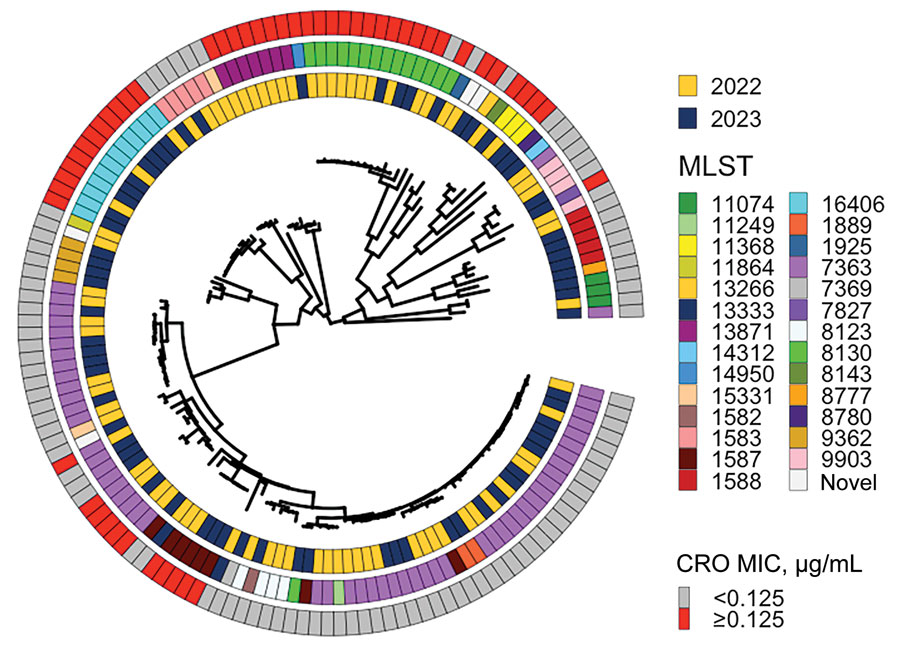Volume 30, Number 7—July 2024
Research Letter
World Health Organization Enhanced Gonococcal Antimicrobial Surveillance Programme, Cambodia, 2023
Figure

Figure. Circular midpoint rooted phylogeny of sequences from Neisseria gonorrhoeae isolates collected by the World Health Organization Enhanced Gonococcal Antimicrobial Surveillance Programme, Cambodia, 2022–2023. Associated metadata, year of isolation, MLST, and presence or absence of elevated MICs for CRO are depicted in concentric rings. White cells in the 3 rings correspond with the tree tip belonging to isolate FC428, the first penA-60.001-containing ceftriaxone-resistant isolate documented in Japan in 2015 (6). CRO, ceftriaxone; MLST, multilocus sequence type.
References
- World Health Organization. Enhanced Gonococcal Surveillance Programme general protocol [cited 2022 Jan 20]. https://www.who.int/publications/i/item/9789240021341
- Ouk V, Pham CD, Wi T, van Hal SJ, Lahra MM. EGASP Cambodia working group. The Enhanced Gonococcal Surveillance Programme, Cambodia. Lancet Infect Dis. 2023;23:e332–3.
- Maubaret C, Caméléna F, Mrimèche M, Braille A, Liberge M, Mainardis M, et al. Two cases of extensively drug-resistant (XDR) Neisseria gonorrhoeae infection combining ceftriaxone-resistance and high-level azithromycin resistance, France, November 2022 and May 2023. Euro Surveill. 2023;28:
2300456 . - Berçot B, Caméléna F, Mérimèche M, Jacobsson S, Sbaa G, Mainardis M, et al. Ceftriaxone-resistant, multidrug-resistant Neisseria gonorrhoeae with a novel mosaic penA-237.001 gene, France, June 2022. Euro Surveill. 2022;27:
2200899 . - van der Veen S. Global transmission of the penA allele 60.001–containing high-level ceftriaxone-resistant gonococcal fc428 clone and antimicrobial therapy of associated cases: a review. Infectious Microbes & Diseases. 2023;5:13–20.
- Nakayama S, Shimuta K, Furubayashi K, Kawahata T, Unemo M, Ohnishi M. New ceftriaxone- and multidrug-resistant Neisseria gonorrhoeae strain with a novel mosaic pena gene isolated in Japan. Antimicrob Agents Chemother. 2016;60:4339–41.
- Tang Y, Liu X, Chen W, Luo X, Zhuang P, Li R, et al. antimicrobial resistance profiling and genome analysis of the penA-60.001 Neisseria gonorrhoeae clinical isolates in China in 2021. J Infect Dis. 2023;228:792–9.
- Liao Y, Xie Q, Yin X, Li X, Xie J, Wu X, et al. penA profile of Neisseria gonorrhoeae in Guangdong, China: novel penA alleles are related to decreased susceptibility to ceftriaxone or cefixime. Int J Antimicrob Agents. 2024;63:
107101 . - Unemo M, Lahra MM, Escher M, Eremin S, Cole MJ, Galarza P, et al. WHO global antimicrobial resistance surveillance for Neisseria gonorrhoeae 2017–18: a retrospective observational study. Lancet Microbe. 2021;2:e627–36.
1Members are listed at the end of this article.
Page created: May 23, 2024
Page updated: June 22, 2024
Page reviewed: June 22, 2024
The conclusions, findings, and opinions expressed by authors contributing to this journal do not necessarily reflect the official position of the U.S. Department of Health and Human Services, the Public Health Service, the Centers for Disease Control and Prevention, or the authors' affiliated institutions. Use of trade names is for identification only and does not imply endorsement by any of the groups named above.